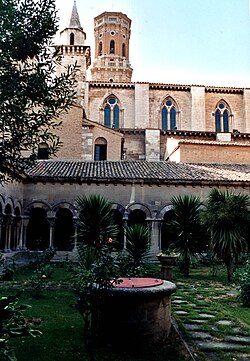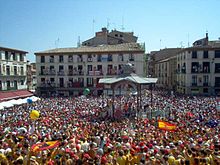Tudela, Navarre
Tudela | |
|---|---|
 | |
| Country | |
| Autonomous community | |
| Province | Navarra |
| Comarca | Ribera Tudelana |
| Judicial district | Tudela |
| Government | |
| • Mayor | Eneko Larrarte (Izquierda-Ezkerra) |
| Area | |
| • Total | 215.7 km2 (83.3 sq mi) |
| Elevation | 264 m (866 ft) |
| Population (2009) | |
| • Total | 34,717 |
| • Density | 160/km2 (420/sq mi) |
| Demonym | Tudelanos |
| Time zone | UTC+1 (CET) |
| • Summer (DST) | UTC+2 (CEST) |
| Postal code | 31500 |
| Website | Official website |
Tudela is a municipality in Spain, the second largest city of the autonomous community of Navarre. Its population is around 35,000. Tudela is sited in the Ebro valley. Fast trains running on two-track electrified railways serve the city and two freeways (AP 68 and AP 15) join close to it. Tudela is the capital of the "Ribera Navarra", the agricultural region of lower Navarre.
The poet Al-Tutili, the 12th century traveller Benjamin of Tudela, the 13th century writer William of Tudela and the physician and theologian Michael de Villanueva were from the city.
The city hosts an annual festival in honor of Santa Ana (St. Anne, mother of Mary) which begin on 24 July at noon and continue for approximately a week. Street music, bullfights and the running of the bulls are typical events of the festival.
History

Archeological excavations have shown that the area of Tudela has been populated since the lower paleolithic era. The town of Tudela was founded by the Romans on Celt-Iberian settlements. Since then the town has been inhabited continuously. The Roman poet Marcus Valerius Martialis (Epigrams Book IV, 55) "recalls in grateful verse" the town of Tutela compared to his native Bilbilis. The city was later taken by the Arabs during the Umayyad conquest of Hispania and became the Muslim emirate of Al-Hakam I in 802 under Amrus ibn Yusuf al-Muwalad.
At the beginning of the 9th century, the strategic importance of Tudela as a site on the river Ebro was enhanced by historical and political circumstances. It became the base of the Banu Qasi family of Muladis, local magnates converted to Islam that managed to stay independent of the emirs, establishing an on-off alliance and close ties with the Kings of Pamplona over the next century. With the power of the Banu Qasi fading at the onset of the 10th century, the town fell under the influence of the rising Caliphate of Córdoba and had to come up against a more aggressive policy on the part of the new dynasty ruling in Pamplona, the Ximenes, who had set up close ties with their neighbouring Christian kingdoms.
The town was used by Muslims as a bridge-head to fight against the expanding Kingdom of Navarre. When Christians under Alfonso the Battler conquered Tudela in 1119, three different religious communities were living there: the Muslims, the Mozarabs and the Jews. In the aftermath of the conquest, community relations appear to have been strained and Muslims were forced to live in a suburb outside the town walls, whereas Jews continued to reside inside the walls (see Jews in Tudela). The co-existence of different cultures is reflected in Tudela's reputation for producing important medieval writers such as Al-Tutili. In 1157 the English scholar Robert of Ketton, first translator of the Koran to a Western tongue (Latin), became a canon of Tudela.
The Jews were banished in 1498 (the expulsion from Navarre occurring slightly later than in the rest of Spain). Muslims and Moriscos were expelled in 1516 and 1610 respectively. There are still examples of Islamic-influenced architecture in the city - the style the Spanish call Mudéjar; but the principal mosque was handed over to The Church in 1121, and by the end of the 12th century construction of the cathedral had begun.
Later Tudela became an important defensive point for the Kingdom of Navarre in battles with Castile and Aragon. Tudela was an Agramont party stronghold and actually the last Navarrese one to surrender to Ferdinand II of Aragon's Aragonese troops in the initial 1512 Spanish invasion of Navarre, only doing so to avoid futile bloodshed, Spanish pillaging and further confiscations to town dwellers, after the Navarrese king failed to send a relief force.
At the end of the 17th century, a new public square was built, called Plaza Nueva or Plaza de los Fueros, which became the main city square.
On November 23, 1808, Napoleon Bonaparte's Marshal Lannes won the Battle of Tudela in the Peninsular War. The train station was built in 1861, which, together with the agricultural revolution, resulted in a new period of expansion for the city.
Main sights


- The Cathedral (12th-13th centuries). It includes examples of Romanesque architecture, such as the Puerta del Juicio, or Door of the (Last) Judgement. There are some Gothic influences and also Baroque additions to the building.
- Church of Magdalene (12th century), in Romanesque style
- Church of San Nicolás (12th century)
- Church of San Jorge (17th century), in Baroque style
- Palacio Decanal
- Stone bridge over the Ebro River
- Torre Monreal
Gastronomy
The Casa Salinas bakery in Tudela, reputed for its excellent mantecadas, closed down in January 2011.[1] Other traditional desserts are manjar blanco and cafareles.[2]
Education
- Universidad Nacional de Educación a distancia
- Universidad Pública de Navarra
- IES Benjamín de Tudela [1] in Spanish
- IES Valle del Ebro
- Colegio San Francisco Javier
- CP Virgen de la Cabeza
- CP Monte de San Julián
- CP Elvira España
- CP Griseras
- Colegio Anunciata
- Colegio Compañía de María
- Escuela Técnico Industrial ETI
People
- Abraham Abufalia, founder of the school of Prophetic Kabbalah. He lived his childhood and some of his youth in Tudela
- Abraham ibn Ezra, scholar - probably born in Tudela
- Yehuda Halevi, poet and philosopher
- Benjamin of Tudela, traveller
- Banu Qasi (not this city's origin)
- Shem-Tob ibn Shaprut philosopher, physician, and polemicist.
- Shem-Tov iben Falaquera philosopher, poet and commentator.
- Robert d'Aguiló (c.1100–c.1159), governor of Tudela
- Robert of Ketton (c.1110–c.1160), canon of Tudela and arabist
- Berengaria of Navarre, wife of Richard the Lionheart.
- Michael de Villanueva, Christian reformer, physician, astronomer, and humanist. Mostly known by the pseudonym Servetus.documents.
- William of Tudela, writer
- Abraham Yom-Tob of Tudela, commentator (JE)
- Francisco de Tornamira, astronomer.
- Hasdai ben Solomon, rabbi (JE)
- Ibn Shaprut, philosopher (JE)
- Joel ibn Shu'aib, author of sermons and Bible commentaries (JE)
- Samuel Amarillo, collector of royal taxes at Tudela (JE)
- Ezmel (Samuel) de Ablitas, financier from Ablitas near Tudela (JE)
- Minir family: scholars of Tudela, members of which are met with in the East and in Italy (JE)
- José Castel (1737–1807), composer of zarzuelas.
- Fernando Remacha (1898–1984), composer
- César Muñoz Sola (1921–2000), artist
- Rafael Moneo (b. 1937), architect
- Ismael Urzaiz (b. 1971), Spanish footballer
Twin towns
 Mauleon-Soule, France, since 1965
Mauleon-Soule, France, since 1965 Tiberias, Israel, since 1984
Tiberias, Israel, since 1984 Mont-de-Marsan, France, since 1986
Mont-de-Marsan, France, since 1986
References
 This article incorporates text from a publication now in the public domain: Singer, Isidore; et al., eds. (1901–1906). "Tudela". The Jewish Encyclopedia. New York: Funk & Wagnalls.
This article incorporates text from a publication now in the public domain: Singer, Isidore; et al., eds. (1901–1906). "Tudela". The Jewish Encyclopedia. New York: Funk & Wagnalls.


